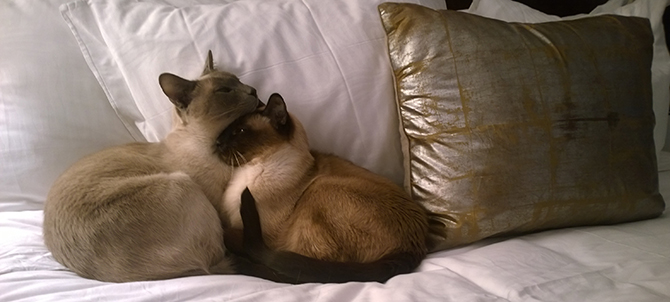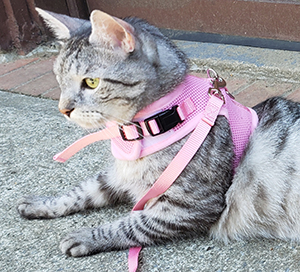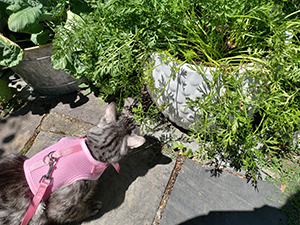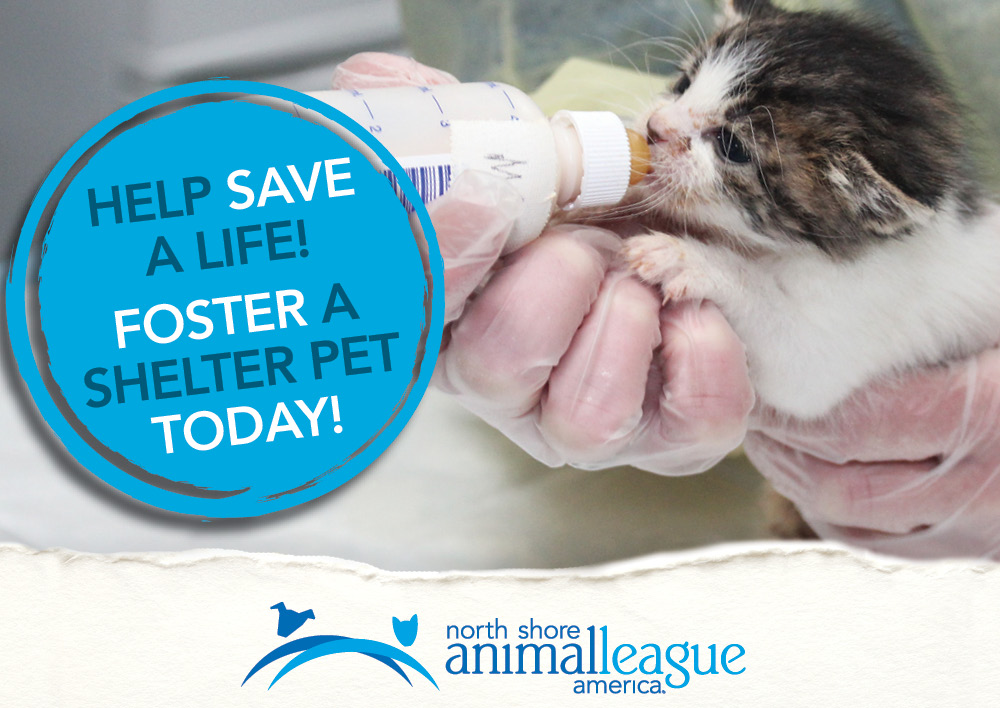TAKING YOUR City Cat to the Country this Summer?
Follow These FIVE Tips TO MAKE YOUR Feline A HAPPY CAMPER

Cats do love to be in the lap of luxury, here are Terrance and Phillip chillin’ at the hotel
By Arielle Bennett and Dr. Eric Dougherty, DVM
Many of us city-dwellers wait impatiently through NYC’s chilly seasons to finally reach our summer getaways. We may choose a quick escape close to home, like The Hamptons, The North Fork (of Long Island), or the upstate wonders of the Empire State, and a select group of us stay regional specifically so we can travel with our cats. Around this time of year, many of our clients at our cat-only veterinary practice in Manhattan (www.thecatpractice.com) often ask us how to best travel with their cats, so here are some tips that may help anyone wondering how to plan for making their city cat into a country kitty this summer.
Book travel with cats well in advance
As one of those crazy cat parents that is nearly incapable of traveling without my cats (I know, I know!), I have learned there are very few accommodations that accept cats as hotel, bed and breakfast, or vacation home guests. In the entire North Fork region, three years ago I called literally every hotel and bed and breakfast, and found only a couple spots that would let me bring one cat. The place we ended up staying at had to inspect our cat on arrival and look over the room before we left – and of course I was guilty the entire trip of having only ¼ of my cats with me! I discovered that these “pet friendly” accommodations almost always meant “dogs-only.” Vacation home sites have the same issue in this region; they advertised as pet friendly but when I messaged about their pet policy, it was the same “no cats allowed” response. Last year I found one house to rent for three days in the Hamptons that finally welcomed my 4 cats. The catch: it was double my budget and smelled of wet dogs when we arrived.
All of this is assuming you’re traveling with cats by car, so if you’re traveling via plane to get to a local U.S. destination, not only will you often need a health certificate from your vet, but you will have to follow the airline’s many everchanging rules as well as most likely book your air travel over the phone via 1980s tech. While this phone call can be a frustrating process, it is important to ask the agent all of your kitty-travel questions so there won’t be any issues at the airport.
 Test a harness system indoors before your let your cat roam outstide. Cats are natural escape artists so be advised that they can probably manage slither out of many a secure-looking harness
Test a harness system indoors before your let your cat roam outstide. Cats are natural escape artists so be advised that they can probably manage slither out of many a secure-looking harnessVisit your vet beforehand and get your cat up to date
Making sure your cat is fully vaccinated with a clean bill of health is better to do before a vacation then during one, especially if your cat is older. Not only will this give you peace of mind while traveling, but it will hopefully prevent needing veterinary services on vacation if you’re going to a place with few vets in the area. This also gives you the opportunity to talk with your vet about how to travel with your cat and minimize your city kitty’s stress on the road and in a new environment. While many cat parents ask us about sedating cats for travel, for most short trips we usually advise against this. We recommend using feliway and catnip, and a favorite toy and cozy bed prepped in your cat’s carrier to begin. For some highly stressed cats there may be anti-anxiety medicine options such as Trazadone if your vet decides this is the best course. Keep in mind, if your cat is trying a new medicine recommended by their vet to travel, usually it’s best to first try it at home one day well before travel to be sure your cat doesn’t have any adverse reactions. It’s never a good idea to try new medicine for the first time while your cat is literally on the road and away from medical care if needed.
Microchipping your cat is a must
Over the years we’ve had a few heartbreaking calls from frantic cat parents that lost their cats on vacation without being microchipped. Don’t let this happen to you! Even if your cat is a city cat 99% of the time, and hopefully you will never need this feature, it’s always better to be on the safe side if an emergency arises. If your cat is lost and then found, any vet office, shelter, or rescue will be able to scan your pet and start the process of getting her back to you.
Flea and tick prevention is useful in the country
While city cats that don’t venture outdoors are rarely exposed to fleas or ticks, country cats are taking a bigger risk and should be given a preventative treatment before vacationing. New York is unfortunately home to ticks in many of our vacation destinations, as anyone that’s hiked through this great land has probably discovered the hard way. While cats tend to be a little more resistant in general to tick borne illnesses than dogs, it is always best to take a cautious approach. Frontline and Revolution preventatives for cats are worth considering for this region, especially if you plan on giving kitty any supervised outdoor time (Frontline does fleas and ticks, while Revolution does fleas and heartworm). Remember, never combine/overlap over the counter flea treatments, and many of these options on the shelves are toxic to cats anyway, so it’s best to discuss prevention options with your vet before trying them at home. In general, flea collars are not recommended as a method of prevention.
 Boney on vacation
Boney on vacation Bring kitty outside only with great caution and supervision
For many reasons, city cats shouldn’t roam outside in the country without close supervision. The chance of escape aside, city cats don’t know the rules of outdoor life. They haven’t been exposed to the elements or predators, and we should never assume that all cats know where they are at all times. Even if they are very food motivated and love you dearly, they can easily get lost, hurt, or even find their way up a tree and have no way to get down, and one mistake is a mistake too many as far as their health and safety are concerned. One of my cats, Boney, is an avid escape artist thanks to his early years living in the countryside and learning about the joys of nature before we became NYC apartment dwellers, so for him I make an outdoor exception on a rare occasion as long as he is on a leash and I am with him at all times. Cats can escape from leashes easily as well, so test a harness system indoors a couple times before venturing outside. Luckily, the few times Boney has gone outside in his old age, his main desire is to roll around and look directly at the sun for some reason, but he also wants to chew on every plant he comes across. Many garden plants, trees, and shrubs are toxic to cats, which is another reason why it is safest to be right there, babysitting your little carnivore, simply to stop them from their ridiculous drive to gnaw on greenery. If not, you will probably have at minimum a puke or two as a result, since eating grass usually has this consequence for kitty.
Arielle Bennett and Dr. Eric Dougherty, DVM are The Cat Practice, veterinarians just for cats. For more information, go to www.thecatpractice.com.













